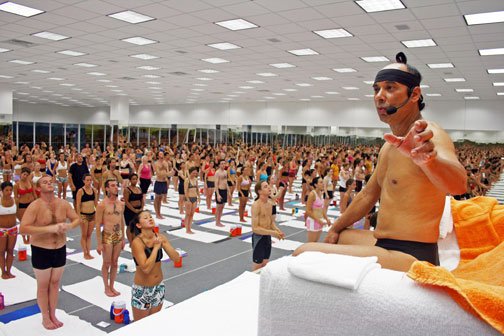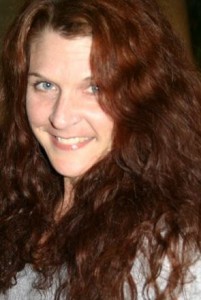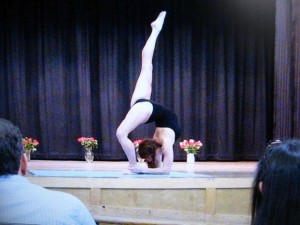
When you personally “get” the systems mindset, you’ll notice others who have it too. Let’s talk about a profitable business model that is as systems-mindset oriented as any I have seen. It’s Bikram Yoga.
Off and on over the last sixteen years, in a number of different studios, I’ve practiced various yoga disciplines. Each studio had a distinct personality and thrust but only Bikram Yoga has precisely choreographed postures, posture sequences and timing. The other practices I’ve experienced have usually been free-flowing and at the whim of the instructor: various poses and pose durations, sometimes music, sometimes no music, with the deportment of the session a product of the mood of the instructor. For me there’s a certain charm in the unexpected but, wrapped up in the flow of a strenuous yoga session, it’s a bit disconcerting. I like to know where things are going. And a too aggressive free-form session can bypass the warm-up necessary to avoid injuries in the more difficult postures. In contrast, a Bikram session works predictably from the gentle to the complex, systematically preparing muscles and joints for the rigorous positions that come near the end of the 90 minute session.
The “Bikram School of Yoga” was created back in the 60’s by Bikram Choudhury in Kolkata, India. Each session includes 26 postures executed in precise order and at the behest of a formally trained Bikram Yoga specialist. Choudhury, now 70, spent years tweaking the routine, working with physicians to examine the tiniest nuances in order to insure the entire system made sense from a biomechanical standpoint. Every part of the body is addressed, cardiovascular, bones, muscles and internal organs. The end result is a perfect system. (Perfect? Yes. Check page 11 of my book Work the System for my pragmatic definition of “perfect.”)
Interestingly, to mimic the conditions in Kolkata, Bikram classes are conducted at temperatures of 100 to 105 degrees Fahrenheit. It is accepted in India that the application of yoga postures with heat is necessary for the proper benefits to occur. The heat component is an important sub-system of the primary system that is Bikram Yoga. The incremental rest/recovery periods that occur between the actual postures is another important sub-system that contributes to the total effectiveness of the primary system.
Each Bikram Yoga session is a mini-epic. Afterwards, one leaves the studio with not just a major feeling of accomplishment, but with a smooth buzz.
Aspiring Bikram yoga teachers gather twice a year for “Bikram Teacher Training” from the master himself. It’s an expensive and grueling nine weeks but the new graduate absolutely “gets” the precision Bikram Yoga practice, ready to return home to teach or set up his or her own studio. Bikram also conducts various workshops in the advanced postures and to re-certify teachers every three years.
There are hundreds of Bikram studio “schools” nationwide, each operated independent of Bikram Choudhury. For the Bikram customer, it doesn’t matter which studio is attended, the basic routine and the room temperature will be the same (although I have seem minor variations in the different studios I’ve used. More on that in a minute).
If I fall out of my regular yoga routine, as I did last summer, I develop multiple aches due to my cycling and climbing proclivities. I returned to Bikram several months ago and by the end of my sixth session was completely pain-free. I’m more limber and less prone to injury, too. As a purely maintenance effort I must stick to the two to three times per-week routine. It’s that simple. As a system that I can depend upon, it’s a beautiful thing but I have to do the work.
Here in Bend, Oregon the local Bikram studio is owned and operated by Susie McLagan. She’s an avid teacher and savvy business woman who I’ve assisted informally with my consulting business. She completely “gets” the beauty of the systematic, unfolding 90 minute Bikram routine.

Exercise: With your systems mindset, examine Susie’s studio carefully and notice the orderliness of it. Enter the front door and the welcoming counter is immediately available with a smiling teacher always available behind it. Conduct your transaction; the process is fast, friendly and efficient (which is a confidence builder for the first-timer). Proceed to the men’s or women’s changing rooms and notice that every element is in place; clean, neat and functional. The benches, hanging racks and shelves are perfectly located for convenience. There are no dirty towels lying about, or supplies stuffed randomly into corners. In the shower stalls there’s always soap in the dispensers, and clean mats on the tile floors to prevent the session-weary student from slipping. Outside in the lobby, necessary accessories are in an attractive display, reasonably priced. The actual studio is always heated to the correct temperature. Details. Details. Details.
Every nuance of the business is orderly, functional and simple. No excess. Form follows function.
The casual observer doesn’t fathom the careful planning and organizing necessary to create this smooth flow. If I had to describe the studio in a word, I would call it “calm.” And not, woo-woo calm. It’s calm because it’s under control and predictable. Things flow. (Regarding flow, read the seminal book, “Flow, The Psychology of Optimal Experience,” by Mihaly Csikszentmihalyi. First published in 1991, it’s a still-popular book and sales remain robust.)
Susie says, “we have an operations manual that provides exact steps for opening and closing the school for each session, talking points for customers at the front counter, detailed instructions for entering student data into the attendance software, preparing a deposit, taking inventory and so on. We have an employee manual that provides guidance for all aspects of conduct and, of course, a detailed instruction manual for teaching the class including exact phraseology and comportment. We have a cleaning manual that lays out in detail how to clean everything from the mirrors to the showers. For each session, there’s a detailed summary checklist to be completed by each shift manager/teacher.”
I’ve been in other Bikram studios and things are not quite so clean and neat: some are without showers (uuugghh!) and for others, the overall layout is clumsy. Some charge too much and others have no accessories for sale. And, I’ve been to studios where the teachers deviate slightly from the Bikram routine. As with everything in life, it boils down to control. Because there is no franchise system, there is only so much Choudhury can do to perfect the individual studios. So if there is to be maximum business success, it’s up to the studio owner to extend the perfection of the Bikram 26 posture primary system to the various mechanical sub-systems of studio operation and the actual class execution. Like any business, if the studio owner doesn’t pay attention to detail and operate the business in a systematic fashion, there will be some degree of chaos and the bottom line will be proportionally anemic.

Bikram Choudhury is both a well respected and controversial figure in the U.S. yoga world. (I’ve noticed that “well respected and controversial” is a not uncommon descriptive for a leader). For instance, he advocates yoga competition while much of the American yoga community sniffs at the idea. This is interesting because yoga competitions have a historical basis in India and virtually all yoga traditions participate in developing and promoting competitions. This is primarily to encourage young people to incorporate yoga “asana” for better health. B.K.S. Iyengar, Pattabi Jois (recently deceased) and other yoga leaders actively tout the benefits of yoga competition. Bikram won the All India National Yoga Championship three times; his wife Rajashree five times. He contends, “Competition is the foundation for all democratic societies. For without competition, there is no democracy.” Of course, I agree. This is assertive application of the systems mindset: To win a competition one must constantly tweak skills to ever higher and higher quality and an impending competition does much to spur enthusiasm.
On separate occasions I’ve briefly met both Bikram and Rajashree. Compelling, electric personalities, they are passionate about what they do and with no help from me, are natural masters of the systems mindset.
Other precisely organized, calm and profitable businesses that demonstrate the systems mindset? Les Schwab Tires (a favorite of mine, located only here in the Pacific Northwest), Costco and Walmart. McDonald’s. Dell computer. The local Audi dealership. Toyota. In your own experience, how about that coffee shop down the street? Two common elements all of these businesses share with Bikram Yoga are the consistent focus on overall goals, and a fetish-like fixation on system improvement.
What about the systems of your own life? Are you precisely managing them?
More information: this is a particularly thorough website, discussing many aspects of Bikram Yoga.
